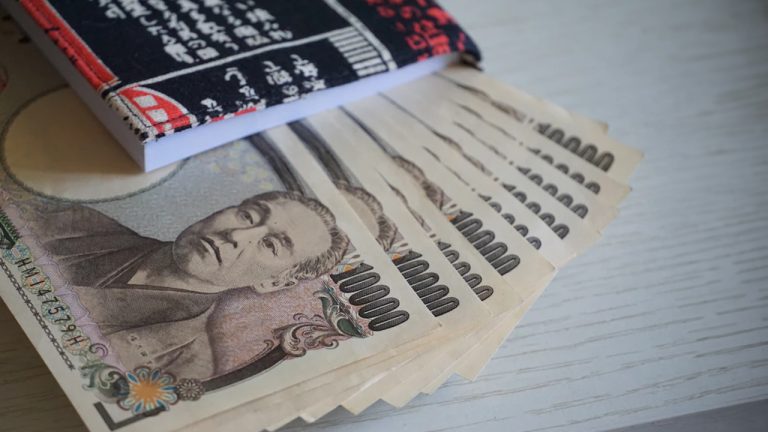 This week, the Japanese yen plummeted to its lowest point since 1990 against the U.S. dollar, weighed down by Japan’s monetary policy and uncertain economic indicators from the United States. Japanese Yen’s Rapid Decline Triggers Talk of Market Intervention The yen’s sharp drop to 158.283 per dollar signals a substantial downturn for the currency. This […]
This week, the Japanese yen plummeted to its lowest point since 1990 against the U.S. dollar, weighed down by Japan’s monetary policy and uncertain economic indicators from the United States. Japanese Yen’s Rapid Decline Triggers Talk of Market Intervention The yen’s sharp drop to 158.283 per dollar signals a substantial downturn for the currency. This […]
China has sold more than $74 billion in US Treasuries in the last year, according to new numbers from the Treasury Department. China has decreased its Treasuries holdings from $849 billion to $775 billion between the beginning of Q2 2023 and Q2 2024, reaching its lowest holdings since 2009. Other countries let go of small […]
The post China Dumps $74,000,000,000 in US Treasuries in One Year As Two BRICS Nations Say They’ve Abandoned Dollar in Mutual Trade appeared first on The Daily Hodl.

Russian President Vladimir Putin says America’s global dominance suffered a serious blow after US politicians decided to blatantly weaponize the dollar. In a new interview with independent journalist Tucker Carlson, Putin says the dollar is the foundation of America’s global might. That foundation was severely damaged, says Putin, when the US responded to Russia’s invasion […]
The post Vladimir Putin Calls US Dollar Weaponization a ‘Grave Mistake’ That Dealt Blow to American Power appeared first on The Daily Hodl.

Earlier this year, PayPal released its own stablecoin. What effect has it had on crypto adoption?
PayPal’s introduction of its native stablecoin, PayPal USD (PYUSD), has sparked heated debates within the crypto industry regarding its possible sway on payments and wider crypto adoption.
While this step seems to be a big jump toward accepting cryptocurrencies in regular finance, some industry observers advise caution.
This initiative aims to bridge the fiat and digital currency realms for consumers, merchants and developers. PayPal CEO Dan Schulman highlighted the need for a stable digital-fiat conduit.
“The shift toward digital currencies requires a stable instrument that is both digitally native and easily connected to fiat currency like the U.S. Our commitment to responsible innovation and compliance, and our track record delivering new experiences to our customers, provides the foundation necessary to contribute to the growth of digital payments through PayPal USD.”

Many users' Binance USD balances will automatically be converted into First Digital USD starting on Dec. 31.
Major cryptocurrency exchange Binance announced it will cease support for all Binance USD (BUSD) products starting on Dec. 15 following Paxos halting the minting of new coins.
In a Nov. 29 notice, Binance said users should withdraw or convert their existing BUSD on the exchange into other assets before Dec. 15. Starting Dec. 31, Binance will disable withdrawals for BUSD. At that point, existing balances will automatically be converted into First Digital USD (FDUSD) for certain users.
In accordance with past communications, #Binance will cease support for BUSD products starting on December 15, 2023.
— Binance (@binance) November 29, 2023
Users may trade or convert their BUSD balances for $FDUSD at zero trading fees.
Full details here https://t.co/usRi09uOhi
The move was the latest by Binance in winding down services for its native stablecoin. The exchange announced it planned to gradually stop support for BUSD before February 2024, starting with ceasing borrowing and lending services for the stablecoin in October.
In February, the United States Securities and Exchange Commission suggested BUSD was an unregistered security in a Wells notice issued to Paxos — the issuer behind the stablecoin. The New York Department of Financial Services also ordered Paxos to halt the issuance of BUSD.
Related: Binance.US asks users to convert USD into stablecoins for withdrawals
On Nov. 21, U.S. authorities announced they had reached a settlement with Binance and former CEO Changpeng Zhao, requiring them to pay $4.3 billion. Zhao resigned as CEO as part of the settlement, with the exchange’s head of regional markets, Richard Teng, stepping into his shoes.
Before August, BUSD was one of the largest stablecoins by market capitalization, reaching a peak of more than $23.3 billion in November 2022. At the time of publication, the stablecoin’s market cap was roughly $1.7 billion, falling by more than 92% in 12 months.
Magazine: Unstablecoins: Depegging, bank runs and other risks loom

Tether USDT added at least $20 billion to its market capitalization in 2023, while rival stablecoin USDC lost the same amount so far this year.
Tether (USDT), the largest stablecoin by market value, has been breaking new records over the course of 2023, with its market capitalization adding at least $20 billion so far this year.
According to data from the blockchain data provider Whale Alert, Tether has minted 22.75 billion USDT so far this year, with at least 4 billion USDT being issued over the past four weeks.
After starting the year with a market cap of roughly $66 billion, Tether USDT has been steadily gaining momentum, with its market value surpassing $80 billion in April 2023. On Nov. 14, USDT market cap briefly hit $87 billion, according to data from CoinGecko.

According to a spokesperson for Tether, the ongoing USDT growth should be attributed to two key reasons, including the ongoing market excitement around the possible approval of a spot Bitcoin exchange-traded fund (ETF).
“There is a growing interest in Bitcoin from institutional investors, driven by the excitement around the possibility of a Bitcoin ETF,” a Tether representative said.
Related: First deadline window looms for SEC to approve Bitcoin ETFs: Law Decoded
Tether's record-breaking growth has also been fuelled by growing demand in emerging markets, according to the company’s spokesperson. The USDT stablecoin has been “increasingly establishing itself as the de-facto digital dollar” for all emerging markets and developing countries, the representative said, adding:
“There are in fact many countries suffering from the devaluation of their national currencies compared to the dollar, hence all the communities living in those countries are seeking protection [...] USDT is the most trusted asset for them.”
Citing public information from the Brazilian government, Tether sai that Tether USDT accounts for 80% of all crypto transactions in Brazil. “This pattern is similar to tens of other countries,” the representative noted.
While Tether has been seeing this surge, some major stablecoins like Circle’s USDC (USDC) have failed to gain much momentum in 2023. After peaking at $55 billion in June 2022, USDC market capitalization has gradually dropped and continued to decline in 2023. Since January 2023, USDC has lost $20 billion in market value, or about 45%. At the time of writing, USDC 's market cap stands at $24 billion, according to CoinGecko.
Magazine: How to protect your crypto in a volatile market — Bitcoin OGs and experts weigh in

Tether has minted 4 billion USDT over the past month, which accounts for nearly 18% of all USDT issued so far in 2023.
Major stablecoin issuer Tether has been increasingly minting new USDT (USDT) tokens, issuing 4 billion USDT over the past month.
Tether issued another 1 billion of Tether on the Tron blockchain on Nov. 10, the blockchain data provider Whale Alert reported. The latest USDT minting came just a few days after Tether issued another 1 billion USDT on Ethereum on Nov. 9, in addition to 2 billion USDT issued in two batches on the Tron blockchain on Nov. 3 and Oct. 19, according to Whale Alert data.
Tether chief technology officer and new CEO Paolo Ardoino commented on Whale Alert data on X (formerly Twitter), noting the latest 1 billion USDT transaction on the Tron network was a “USDT inventory replenish.” He wrote:
“Note this is an authorized but not issued transaction, meaning that this amount will be used as inventory for next period issuance requests and chain swaps.”
The recently issued USDT makes up a significant share of the total USDT issued this year. Based on Whale Alert data, Tether should have minted 22.75 billion USDT in 2023, with 13 billion, or 57%, having been issued on the Tron blockchain. The remaining amount of 9.75 billion USDT was issued on the Ethereum blockchain.

Tether has been actively minting new USDT stablecoins over the past year. In March 2023, Tether minted a whopping 9 billion USDT coins, in addition to the 3 billion minted over the previous month, according to Whale Alert data. The stablecoin issuer also minted a significant amount of USDT in mid-summer, issuing 3.75 billion USDT between June 12 and July 12.
While actively minting new stablecoins, Tether has also been burning some coins. On Aug. 22, Tether burnt 1.2 billion USDT on the Tron blockchain. Previously, the stablecoin firm also burnt 3.1 billion Tron USDT in June and 2 billion Ethereum USDT in February, according to Whale Alert.
The cryptocurrency community has quickly reacted to the most recent USDT minting transactions. One crypto enthusiast took to X to share some observations about how previous aggressive Tether USDT minting affected the market.
“Last time this much Tether got printed in a week a whole bank blew up,” the poster noticed, referring to banks like Silicon Valley Bank, Silvergate and Signature Bank shutting down operations in March 2023.
In the aftermath of the bank implosions, some industry observers alleged exposure between Tether and Signature. Tether subsequently denied such allegations, “unequivocally re-iterating” that it had no exposure to Silvergate, Silicon Valley Bank and Signature Bank.
Related: Tether issues $610M debt financing to Bitcoin miner Northern Data
In addition to the active minting of new coins, Tether has been working to integrate a major ecosystem part recently, according to Ardoino. Tether's CEO took to Twitter to announce that the firm is preparing to announce five new projects in 2024. “Couple of these could obliterate some popular Web2 centralized services for good,” he noted.
We're quite close to add another extremely powerful piece of the puzzle for @Tether_to ecosystem.
— Paolo Ardoino (@paoloardoino) November 12, 2023
Total of 5 mind-blowing projects (and counting) for 2024.
Couple of these could obliterate some popular Web2 centralized services for good.
Pure Real World Ecosystem aka "Things…
Tether did not immediately respond to Cointelegraph’s request for comment.
Magazine: How to protect your crypto in a volatile market — Bitcoin OGs and experts weigh in

In September 2023, Tether also invested an undisclosed amount in Northern Data in a move backing AI initiatives.
Tether (USDT) stablecoin issuer is raising the bet on Bitcoin (BTC) mining by issuing a major debt facility to German-based BTC mining company Northern Data AG.
Northern Data AG has secured a 575 million euro ($610 million) debt financing facility from Tether to drive further investments across its businesses, according to an announcement on Nov. 2.
The debt capital specifically aims to enable Northern Data Group to invest in its three business lines including its artificial intelligence cloud service provider Taiga Cloud, Ardent Data Centers and Peak Mining, the company’s mining business.
The focus of these investments will be on the acquisition of additional hardware and scaling Bitcoin mining operations with liquid-cooling mining technology, the announcement notes.
According to the announcement, the debt facility is unsecured, at standard market conditions and has a term until Jan. 1, 2030.
Related: No concerns over Bitcoin halving supply shock, says Bitvavo CEO
The debt financing comes after Tether acquired a stake in Northern Data. In September 2023, the USDT issuer invested an undisclosed amount in Northern Data in a move aimed at backing AI initiatives. Tether claimed the investment was separate from its reserves and would not impact customer funds. Tether has been actively moving into Bitcoin mining operations in 2023, launching its own mining operations and introducing proprietary mining software.
According to Tether’s Q2 attestation from accounting firm BDO, the stablecoin company increased its excess reserves by $850 million, bringing total excess reserves to $3.3 billion. In September 2023, also reported that its stablecoin loans surged despite the company working to cut such loans to zero last year.
Magazine: How to protect your crypto in a volatile market — Bitcoin OGs and experts weigh in

e-HKD Phase 1 trial was dedicated to full-fledged payments, programmable payments, offline payments, tokenized deposits, settlement of Web3 transactions and settlement of tokenized assets.
The Hong Kong Monetary Authority (HKMA) is gearing up for the second phase of the e-HKD (e-Hong Kong dollar) pilot program as it announced the successful completion of the Phase 1 trial of its in-house central bank digital currency (CBDC).
The HKMA launched the e-HKD pilot program in November 2022 to evaluate the commercial viability of an in-house CBDC as part of its “Fintech 2025” strategy. Phase 1 was dedicated to studying e-HKD in six areas, which include full-fledged payments, programmable payments, offline payments, tokenized deposits, settlement of Web3 transactions and settlement of tokenized assets.

Detailing the findings of the e-HKD phase 1 trial, the HKMA report highlighted programmability, tokenization and atomic settlement as three key areas where Hong Kong’s CBDC could benefit consumers and businesses.

The report read:
“The next phase of the e-HKD pilot program will build on the success of Phase 1 and consider exploring new use cases for an e-HKD.”
HKMA plans to “delve deeper” into some use cases that showed promising CBDC applications in the phase 1 trial. Technical considerations show an inclination toward using distributed ledger technology (DLT)-based design considering its interoperability and scalability capabilities.

As shown above, Hong Kong’s CBDC program consists of a three-rail approach — foundation layer development, industry pilots and iterative enhancements and full launch. Currently, at its second rail, the e-HKD program trial is supported by public and private organizations to ensure commercial viability for both parties.
HKMA said it will also continue to work on rail 1 initiatives such as laying the legal and technical foundations for e-HKD.
Related: Hong Kong lawmaker wants to turn CBDC into stablecoin featuring DeFi
Alongside localized efforts for CBDCs, numerous central and commercial banks joined hands under Project mBrigde to explore solutions for faster, cheaper, more transparent cross-border payments.
On Sept. 25, HKMA CEO Eddie Yue revealed that mBridge will expand and be commercialized as it welcomed new banking members from China, Hong Kong, Thailand and the UAE.
“We are expecting to welcome more fellow central banks to join this open platform. And very soon, we will launch what we call a minimum viable product, with the aim of paving the way for the gradual commercialization of mBridge,” Yue added.
Magazine: Ethereum restaking: Blockchain innovation or dangerous house of cards?

Banking giant Goldman Sachs says that China is weathering the biggest capital flight since 2016 amid struggling equities markets. In a report seen by the South China Morning Post (SCMP), Goldman says foreign investors sold off a net total of $3.3 billion in domestic Chinese stocks, bringing the total outflows for October to $5.1 billion. […]
The post China Sees Biggest Capital Flight in Seven Years As $5,100,000,000 Exits Struggling Stock Market: Report appeared first on The Daily Hodl.